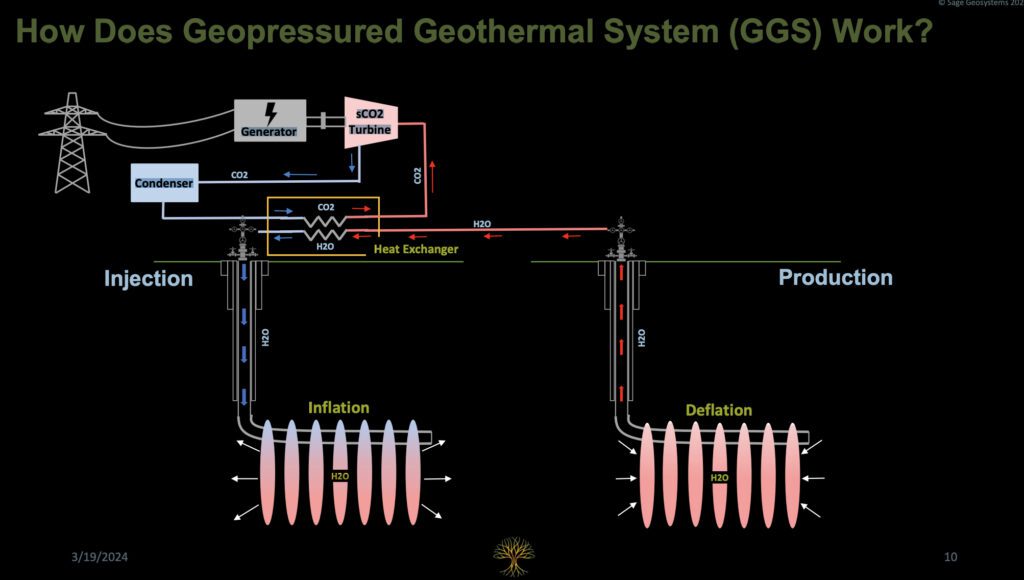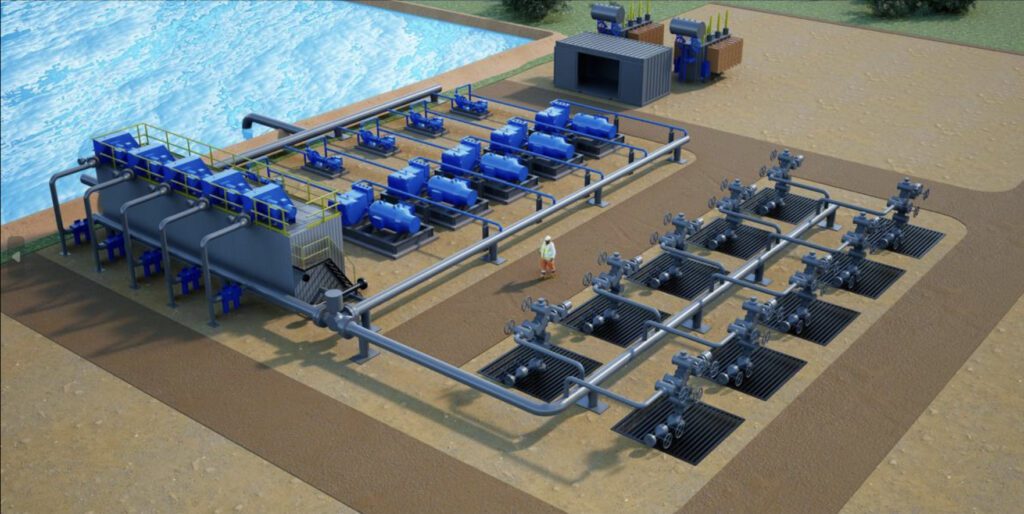Sage’s First 3-MW Geothermal Power and Energy Storage Project Will Feed ERCOT
Sage Geosystems will build a first-of-its-kind 3-MW geothermal baseload power and energy storage system on land owned by San Miguel Electric Cooperative (SMECI) in Christine, Texas. The company plans to begin operating the project later this year to supply the Electric Reliability Council of Texas (ERCOT) grid.
The project will mark the first commercial-scale deployment of EarthStore, Sage’s proprietary Geopressured Geothermal System (GGS), the company said on Aug. 13. Sage plans to operate the project as a merchant, buying and selling electricity to the ERCOT South Load Zone.
“Once operational, our EarthStore facility in Christine will be the first geothermal energy storage system to store potential energy deep in the earth and supply electrons to a power grid,” said Cindy Taff, CEO of Sage Geosystems.
A Cost-Effective ‘Underground Battery’
The system essentially uses mechanical energy storage technology to harvest both the heat and pressure of subsurface fluids in geothermal wells. Like a conventional enhanced geothermal system (EGS), Sage’s Earthstore utilizes a two-well fracking system. But instead of harvesting only the heat from the working fluid, it also leverages the pressure.

“We’re focused on the thermodynamics and the geomechanics of getting the heat out of the well,” Taff explained to POWER at CERAweek by S&P Global in March. “We pump the water into the fracture so it opens up like a balloon. When we want the water back, we let Mother Nature close the fracture, and that basically jettisons the water, so we don’t have to pump it out, which means that we don’t have to spend this huge amount of energy to get energy out.”
Sage’s technology is suited to low-permeability rock formations, typically found below depths of 5,000 feet. The fractures, which serve as artificial underground reservoirs, are created using gravity fracking, she noted. When electricity demand is low, Sage will use grid power to power and electric pump, which will inject water into the fracture, causing it to “balloon.”
“The rock formation has elasticity, so as the water is pumped in, the fracture opens up and stores the pressurized water,” Taff said. “This pressurized water is essentially the stored energy.” When electricity is needed, Sage will open the wellhead valve, which allows the pressurized water in the fracture to flow back out rapidly to spin a high-pressure Pelton turbine to generate power.
“The key advantage of this ‘balloon’ approach is that we can do load following. Or we can do peak load, where you’re letting all the water out,” she explained. “You can do that with the same well design and the same power plant design. The only difference is, if you want it produced for 17 or 18 hours, and then you want to charge within a 24-hour period, like seven hours, you would need more injection pumps, which means your capital goes up. But other than that, all of the design is the same.”
The project in Christine, which will be built near SMECI’s 391-MW lignite coal power plant, will be capable of energy storage durations of six to 10 hours, with a round-trip efficiency (RTE) of between 70% and 75%, Sage said in a statement on Tuesday. “In addition, water losses are targeted to be less than 2%. At scale, this energy storage system will be paired with renewable energy to provide baseload and dispatchable power to the electric grid.” When combined with solar power, Sage’s EarthStore facility “enables 24/7 electricity generation at a blended Levelized Cost of Energy (LCOE) well under $0.10/kWh,” it added.
Rapid Development for a Concept that Leans on Oil and Gas Expertise
The commercial facility in Christine will be based on a full-scale commercial pilot that Sage demonstrated over five weeks in an existing oil well on a ranch south of San Isidro in Starr County, Texas, starting in March 2023. The pilot produced 200 kW for more than 18 hours (long-duration) and 1 MW for 30 minutes (load-following) with Pelton turbines, with a round-trip efficiency of up to 75% and water losses of less than 2%, Taff said.
The pilot followed only 2.5 years of development by Sage, a company founded in 2020 by a team that boasts a combined 150 years in the oil and gas industry. That’s primarily because the company has leaned heavily on existing oil and gas drilling equipment and techniques, which include casing and perforation, Taff said. “The only difference is we use a heavier fluid when we fracture. It’s called gravity fracking.”
However, as Taff underscored, GGS has been in continuous field testing. “After getting our funding in mid-2021, we got to the field, and we wanted to test two of our technologies for geothermal. One was gravity fracking, where we can frack downward toward the heat,” she said. “But then after we created the fracture, we actually spent about five months in the field operating that fracture.” The five-week pilot in March 2023 was focused on Sage’s energy storage solution, an initiative that allowed it to demonstrate load following and long-duration storage, she noted.
For effective energy storage, Taff suggested drilling should reach between 8,000 feet and 12,000 feet, which represents “90% of the U.S.” It means “you can put energy storage just about anywhere,” she said. For geothermal power, “We’re really looking for the temperature of the formation, 150C or greater,” which geographically limits development to about 35% of the U.S.
Engineering a More Powerful Pelton Turbine
Still, for now, Sage is also working on re-engineering the Pelton turbine, a widely used impulse water turbine, as a critical component for the GGS. “As you can imagine, the highest mountain that is currently being used for pumped hydro is 3,000 feet, and we’re going down to 7,000, 8,000, 10,000 feet, so we need a 5000 PSI Pelton turbine” for a 3-MW system, Taff noted. The company is currently working with a partner on engineering the component for delivery by October 2024, she said.
The company has also developed a 3-MW supercritical carbon dioxide (sCO2) turbine that it plans to use in its geothermal applications. “The advantage of this is that it’s smaller,” she said. “So it’s going to be cheaper to build, but more importantly, it uses a hybrid Brayton cycle, meaning that you get more electricity out per unit of heat that you put in.”
While Sage’s first commercial project in Christine will comprise a single well, an injection pump, and a single Pelton turbine, scaling up to 30 MW will be a “techno-economic decision” based on future project needs, said Taff.
Currently, Sage is targeting several key markets suited to the technology’s capabilities, such as for microgrid, remote grid, and commercial and industrial applications. However, the technology is also well suited for grid balancing in markets like ERCOT. “Long-duration energy storage is crucial for the ERCOT utility grid, especially with the increasing integration of intermittent wind and solar power generation,” said Craig Courter, CEO of San Miguel Electric, on Tuesday.
Taff said that GGS is already showing cost competitiveness with several existing technologies. “We are not targeting to beat lithium-ion batteries for less than two hours, but if you have to start stacking lithium-ion batteries for four hours or more, then we can beat lithium-ion batteries, and we can beat pump storage hydropower right now, both on the upfront capital and on the [levelized cost of storage (LCOS)].”
Geothermal power costs pose a different challenge, she noted. “Our goal for a one-off pre-scale is to deliver 9 cents/kWh LCOE,” she said. “That is exciting in Germany and in California, but what we really want to do is build geothermal so that it can be cost-competitive in Texas and other places.” Scaling up will be crucial, she noted.

Projects In the Pipeline
Sage said it is now gearing up to apply for a drilling permit in Atascosa County for the EarthStore facility in Christine. However, the company said it will also apply for a second permit is in Starr County, adjacent to the company’s existing test well.
The company is already also fielding interest abroad. On July 24, Sage said it would partner with Romanian generator Electrocentrale Bucuresti S.A. (ELCEN) to explore how geothermal energy technology can be implemented within the city of Bucharest to replace a fossil-fuel-based thermal plant. ELCEN currently produces 40% of Romania’s and 90% of Bucharest’s thermal energy for district heating, and implementing a renewable energy source like geothermal would significantly reduce carbon emissions throughout the city and the country, Sage said. “The first project will generate up to 70 MW thermal power for a district in Bucharest and, upon its success, will be expanded to other Romanian projects and cities,” it said. “A feasibility study will be performed in partnership with the National Renewable Energy Laboratory (NREL).”
Earlier this year, Sage also set out to explore the potential to deploy its proprietary GGS technology at Fort Bliss for the U.S. Army and the Defense Innovation Unit (DIU). “Additionally, the company will evaluate the potential synergies of hybrid technologies such as direct thermal use, energy storage, and dispatchable power to support cost-effective energy resilience,” the company said.
—Sonal Patel is a POWER senior editor (@sonalcpatel, @POWERmagazine).